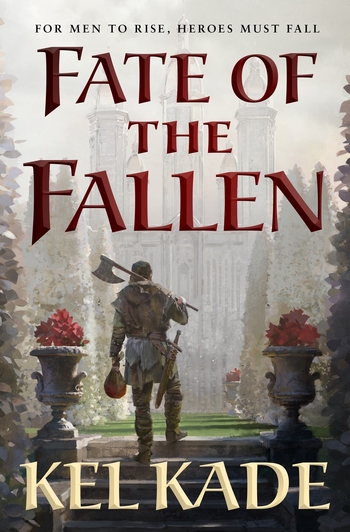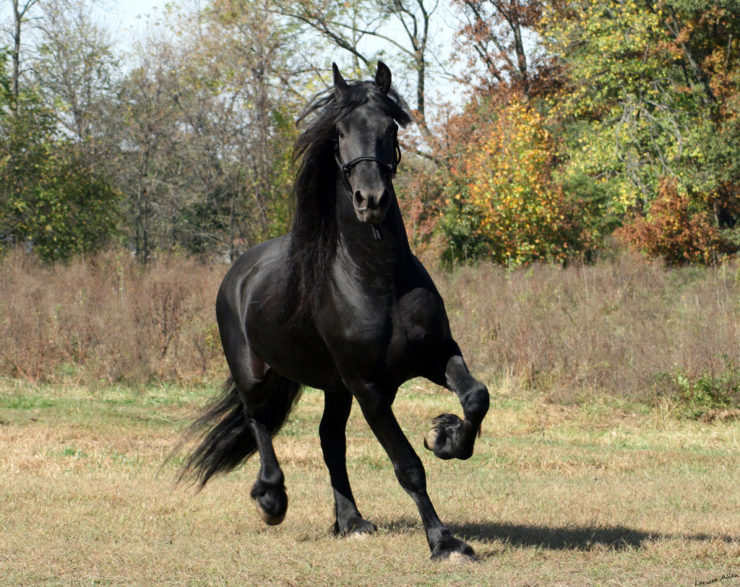It’s 1985. There’s a new film out with an almost too twee title, Ladyhawke. Supposedly it’s based on a medieval legend, but really it’s a secondary-world fantasy with fairytale overtones. It’s lush and romantic and blessed with beautiful faces—Michelle Pfeiffer, Rutger Hauer, young and luminous. It’s full of fantasy tropes: the thief who makes good, the lovers tragically sundered, evil aristocrats and wicked clerics, curses and shapeshifters.
All of which is pure joy for the fantasy fan, and while the graduate medievalist has many reservations about the accuracy of the setting or the provenance of the story, it’s so very, very pretty. Prettiest of all—even prettier than young Rutger with his ice-carved cheekbones—is Rutger’s horse, who is a character in his own right.
Most of us have never seen anything like him. Huge, black, glossy, with masses of flowing mane and tail and leg feathers, Goliath is a horsegirl’s dream. He has tremendous presence; his gaits are spectacular, especially his flashing trot. And Rutger can ride, which shows off their mutual beauty even more.
The camera loves Goliath, and so do we. There’s no easy way yet to find out what breed he is, but gradually we discover that he’s played primarily by a stallion named Othello, and that Othello is a Friesian horse.
Buy the Book


Fate of the Fallen
Popular films have a way of sparking disastrous animal fads—Disney’s 101 Dalmatians is particularly infamous for inciting epidemics of Dalmatians in animal shelters and dog rescues. Horses are expensive enough and Friesians rare enough that Ladyhawke didn’t lead to the same tragic consequence. But thanks to Goliath, a little known breed became much more popular in the United States—a popularity that persists over three decades later.
The Friesian horse is native to Friesland in the Netherlands. It’s supposedly descended from the Great Horse of the medieval knights, and is at base a draft breed, as the leg feathers indicate. It’s also on the heavier end of the Spanish cousins, having been crossed on the horses of Spain in the Baroque era. Hence the lighter build and the high, arched neck and proud carriage, though the original stock persisted in the leg feathering and the structure of the hindquarters, which is suited to pulling rather than tucking under and lifting.
What we now know as the Friesian is a product of the eighteenth and nineteenth centuries—just about when other European breeds started focusing on closing their studbooks and concentrating their gene pools. This cross of draft and Spanish lines was not only a coach horse (including funeral coaches, for which these spectacular black horses were ideal) and a mount for the aristocracy, but also a popular choice for short-distance trotting races. That big, bold trot has some speed in it, though the draft heritage doesn’t favor endurance over distance.
It’s not a huge horse, though not a small one, either. Ideal height is around 16 hands, going up to 17 and down to 15, which is about where Andalusians and Lusitanos are these days. Most of the impression of size comes from the substantial build and the high arched neck.
Enthusiasts in this new millennium are still showing off their Friesians and Friesian crosses in harness—including some very showily marked pinto and Appaloosa-spotted horses. While the main registry is not at all happy with outcrossing and will not register any horse of any color but solid black with no white markings on the legs or body, maverick breeders especially in the U.S. are trying all sorts of combinations including Percheron, Andalusian, and Lipizzan. Friesian blood and type tend to come through in body shape, knee action, and of course the hair.
And temperament. These are truly lovely horses, with the calm of their draft ancestors and the soft fire of the Spanish breeds. They’re prized as dressage mounts at the lower levels; their patience and tolerance for repetitive exercises, combined with their striking looks, make them stand out in the show arena.
And much of that is thanks to the horse wrangler who chose that beautiful black stallion to be the horse star of Ladyhawke. Goliath (as played by Othello) truly does embody what the Friesian is: beauty, presence, temperament, devotion to his person. It’s said he and Hauer formed a bond offstage as well as on. He’s a dream horse, a fantasy horse, but also a very real one.
One of my more surreal memories is of taking my first Lipizzan to a large boarding facility for a weekend riding clinic. We arrived after dark, and the stall she’d been assigned was next to a Friesian.
There we were, with my little white mare glowing under the lights, and this huge black horse making love-noises at her and prancing a little for her (no worries, he was a gelding). All the horsegirls were sighing at the sight. Two fantasy dreamhorses in one place. I don’t think any of them ever forgot it.
Photo by Larissa Allen, licensed under the Creative Commons Attribution-Share Alike 3.0 Unported license, via WikiMedia Commons.
Judith Tarr is a lifelong horse person. She supports her habit by writing works of fantasy and science fiction as well as historical novels, many of which have been published as ebooks by Book View Cafe. She’s even written a primer for writers who want to write about horses: Writing Horses: The Fine Art of Getting It Right. Her most recent novel, Dragons in the Earth, features a herd of magical horses, and her space opera, Forgotten Suns, features both terrestrial horses and an alien horselike species (and space whales!). She lives near Tucson, Arizona with a herd of Lipizzans, a clowder of cats, and a blue-eyed dog.










